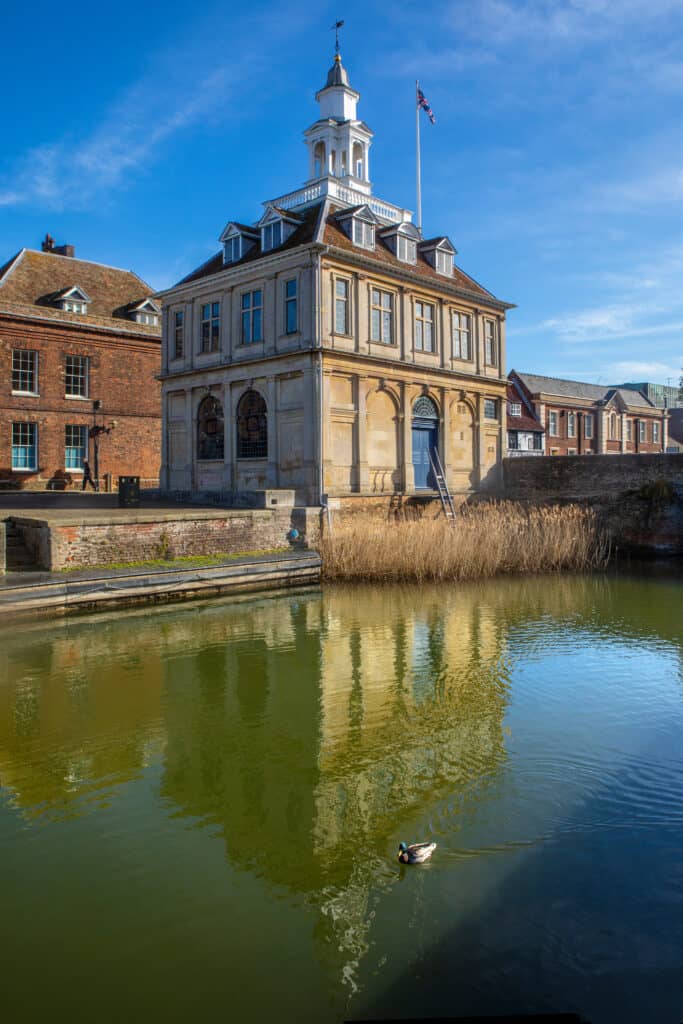
Lynn Museum and a Town Worth Its Salt
A long time ago the only currency worth its salt was…salt. Roman soldiers were paid in salt, and from that we get the word ‘salary’. And there’s plenty of salt sprinkled through the history of maritime King’s Lynn in West Norfolk. The town began with salt and the lucrative industry of extracting it from the shores of a now lost ‘linn’, a Celtic word for pool and the first name of the town. Salt was used to preserve meat and fish for long winters, a matter of survival. The salt business developed through the patronage of the Bishops of Norwich who laid the foundations of medieval Linn, or Bishop’s Lynn as was later called. When Henry VIII broke with Rome the town was renamed King’s Lynn.
Find out more at Lynn Museum, an architectural gem hidden in the corner of a busy bus station. Tucked into a former chapel, this small museum is packed with stories and an eclectic array of artefacts including Horace, a Tiger killed by a King, fairground gallopers made by engineer Frederick Savage and, most impressively, a haunting Bronze Age oak circle.
Seahenge, as it’s now known, was originally constructed on a lonely saltmarsh. Protected from the sea by sand dunes and mud flats, it became hidden beneath a layer of peat, which eventually covered the henge and prevented it from decay. Loaned to the British Museum as the centrepiece of its acclaimed Stonehenge exhibition, Seahenge’s purpose is shrouded in the mists of the past.
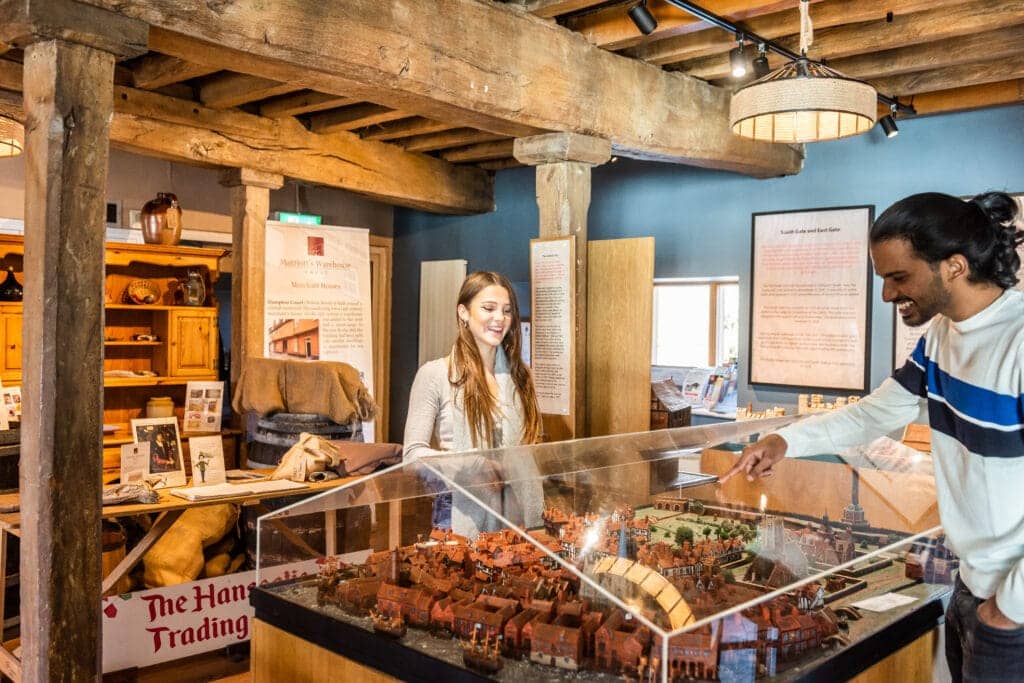
Warehouses on the Wash
On the banks of the River Ouse in King’s Lynn stands the last surviving Hanseatic building in England. The brick Hanse House gets its name from the German traders who once owned it, a relic from the days of the Hanseatic League, the powerful medieval trading bloc that stretched all the way from King’s Lynn to the heart of Russia. Lasting hundreds of years, it was one of the most successful trade alliances in history, winning the loyalty of nearly 200 towns around the North Sea and the Baltic and securing the prosperity of north west Europe.
Another reminder of King’s Lynn’s global trading prominence is Marriott’s Warehouse, now a popular restaurant with some of the finest views in town. It’s thought to have been built in its present form by local merchant Thomas Clayborne around 1580 as a store for corn, salt and wine. However, some of great oak beams date back to the 1300s, when the site was already a bustling riverside quay. It’s quiet down by the river these days, but back then the whole quayside would have been rammed with every kind of landing stage, or ‘staithe’, both public and private, where cargoes of wax, wool and pepper were unloaded by sailors and merchants, yelling orders and oaths in a cacophony of languages. Then, the tidal waters of the Ouse would have lapped around the warehouses with ships moored right outside, and by evening the town taverns were full of characters from all over Europe.

Stories of Lynn
Wife, mother and businesswoman. Sounds like an average Instagram bio. But Margery Kempe was no average woman. Born in King’s Lynn (then Bishop’s Lynn) around 1373 she was also a pilgrim, visionary and author of the earliest surviving autobiography in English. The Book of Margery Kempe recounts in vivid, candid detail the madness that followed giving birth to her first child when she was about 20, very likely the first recorded account of postpartum depression and psychosis. But this was the 14th century so hallucinatory encounters with devils, demons, the Virgin Mary and Christ were expressed through the lens of a fervently religious society and Margery felt called to the spiritual life. In 1413 she visited the anchoress and Christian mystic, Julian of Norwich, took a vow of chastity (after having 14 children) and then set off on a pilgrimage to Jerusalem, followed by a second to Santiago de Compostela. A courageous, unorthodox woman, she was often accused of heresy yet refuted all false charges against her armed with an extraordinary knowledge of theology. All the more remarkable for a woman who dictated her extraordinary memoir, being unable to read or write.
Find out more about Margery at the fascinating Stories of Lynn Museum. Also on display are town treasures such as the beautiful King John Cup, a 14th-century drinking vessel, lavishly decorated in gilt and enamel, a very rare example of a secular medieval cup.

Vancouver
The maritime town of King’s Lynn was once a departure point for hundreds of young Norfolk adventurers hungry to see the world. The Lynn streets were full of sailors and merchants from overseas, spilling onto wharfs and quaysides from ships of every kind, with crews from all over the world. Vessels were unloaded and restocked from busy warehouses, corn was exported, and wines imported, a trade depicted on two figureheads of the towns Custom House.
Architect Henry Bell designed Custom House, then a centre for collecting tax on goods imported and exported from the town. In one of the upstairs rooms worked a diligent chap called John Jasper Vancouver, but it was his son, George, who gave the family name to landmarks across the globe. George Vancouver joined the Royal Navy at the mature age of 13 and accompanied Captain James Cook on two voyages including his last to Hawaii (1772-75 and 1776-80). On 1st April 1791, Vancouver took command of an expedition to chart North America’s northwestern Pacific Coast, from San Diego California to Anchorage Alaska including the Canadian province of British Columbia. His mapping measurements were so precise they can still be used today.
Vancouver Island, the city of Vancouver, Vancouver in Washington, Mount Vancouver on the Canadian American border and even New Zealand’s sixth highest mountain are all named after that man who set sail from a small town in West Norfolk when he was just a boy. His statue now stands on Purfleet Quay.

Nip and Growler Craft Ale House
Back in the 1500s you could buy eels and candles from Nip & Growler. But in those days it was called The Bull, a rowdy tavern near King’s Lynn’s busy riverside quay, packed with sailors letting off steam. Now a Craft Ale House, this award-winning gem is run by two best mates who know their booze only too well. It was designed and built by their own fair hands with local tradesmen using local recycled materials, proving new isn’t necessarily better. In fact this site is home to the oldest pub in Lynn, first recorded in 1348 when the Black Death was ravaging the country. No wonder people needed a drink.
With board games and playing cards always available, there’s a warm welcome for everyone who loves something memorable and different, great for holing up on a rainy winter evening to savour local ales sourced from nearby micro-breweries. There are 13 ales & ciders on tap, changed daily to introduce customers to a different way of drinking. It’s about flavour not quantity, so you can choose your tipple served in ⅓, ½, ⅔ pint measures. If want to discover a new ale or cider to thrill your taste buds just ask for tasters before you buy. There’s a good selection of wines and spirits plus soft and fruit drinks and bar snacks. The ales are changing all the time but the owners’ attitude to life remains the same. Drink, be merry, be kind and never laugh at a bad joke.
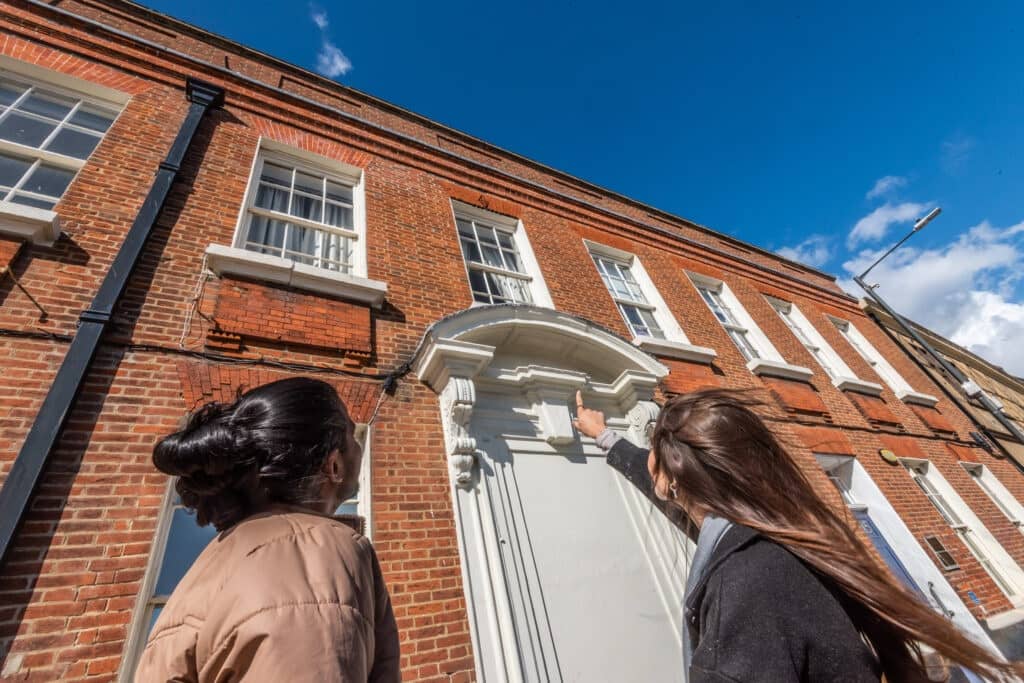
The Witches Heart
King’s Lynn. Friendly isn’t it? But this handsome West Norfolk town has a dark heart. And they say it belonged to a witch. Inside a diamond carved into the red brick above a window of Numbers 15 and 16 Tuesday Market there’s the shape of a heart, said to be the mark of Margaret Read, aka Shady Meg, who was burned at the stake in 1590. As she screamed in an agony of fire, her still-beating heart ripped itself from her chest, slammed into the wall at the marked spot and defying gravity, flew to the River Ouse where the waters bubbled like a cauldron as Meg’s heart sank beneath.
And you didn’t have to be suspected of witchcraft to meet a horrifying end. Found guilty of poisoning her mistress, in 1531 a King’s Lynn maidservant, whose lonely name is forgotten, was wrapped in chains draped over a gibbet above a cauldron of boiling water. She was plunged in, over and over again, until she died. There are only two other records of execution by boiling water in the UK, both at Smithfield in London, and both servants accused of poisoning.
But the real heartbreak is the way a society consumed by fear and superstition launches violent crusades against the most powerless. And the horror is, we still do. Can there really be justice for our murdered ancestors? How did they spend the last hours of their lives? We can at least bear witness to their infinite sorrow.
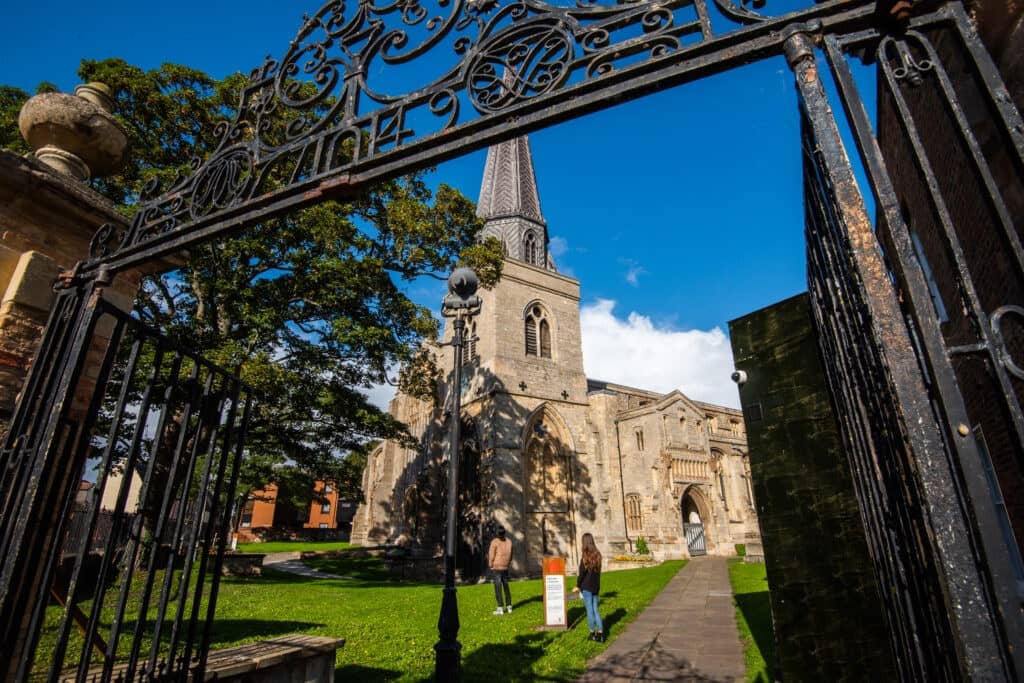
The Chapel of Angels and Fishermen
The grey-blue spire of St Nicholas, patron saint of sailors (and, as Santa Claus, of children) has soared to the sky above Lynn for over nine centuries. This radiant town centre chapel is the largest in England, full of stories illustrating King’s Lynn’s long history as a busy commercial port and some darker tales, for it’s reputed the ground along the path is high due to the number of plague victims buried beneath. The carved woodwork is of such quality that some is now in the V&A Museum. In the fifteenth-century wooden roof, carved angels sing with wings outstretched, while in the medieval stalls strange cavorting figures suggest an older faith.
Situated in what was once ‘Newland’, St Nicholas was known as the Fishermen’s Chapel, spiritual home for the North End fishing community. The fine Christian folk of the town sniffed at sitting next to rough dressed fisherfolk so a pew system prevented anyone of low status sitting in the front seats. One hopes the good Lord gave special attention to the people at the back.
When the chapel was reseated in the 1860s, Canon Wodehouse announced a new service, opening the whole chapel every Sunday evening, ‘when old dresses and thread-bare coats would come perhaps with less restraint’. This achievement led to what in 1868 was described as ‘the largest congregation in town, fishermen may be seen in their white and blue slops, and they confess…it is the happiest day of the week.’

Fisherfolk of Trues Yard
Norfolk has many hidden histories, tales of people and communities now lost and forgotten. World history, they say, is written by the victors, but local history is preserved in the memories of the people. True’s Yard is a small community-driven museum in King’s Lynn where the history of the town’s North End is kept alive. Many of those who run True’s Yard are descendants of the fisherfolk whose lives are celebrated here. This fascinating heritage site takes you on a journey through a once thriving community, when hundreds of families lived in the shadow of the medieval Chapel of St Nicholas. True’s Yard is a unique social history of life in a world that was hard and often short and champions collecting oral history from the public.
The North Enders were self-reliant fishing families, largely socially excluded from the rest of the town. They built their own boats and had their own sailmakers, bakehouses, school and pubs. Supporting each other in times of crisis, their births, marriages and deaths rarely involved anyone beyond the boundaries of the North End, even though the men, in their colourful gansies (jumpers), often sailed hundred miles from their homes in search of a good catch.
The buildings themselves are notable, as not many working class dwellings survive from Georgian times. Back in 1802 two of the original four cottages that once existed on the museum site were owned by a Mr William True, whose name is honoured by True’s Yard Museum.
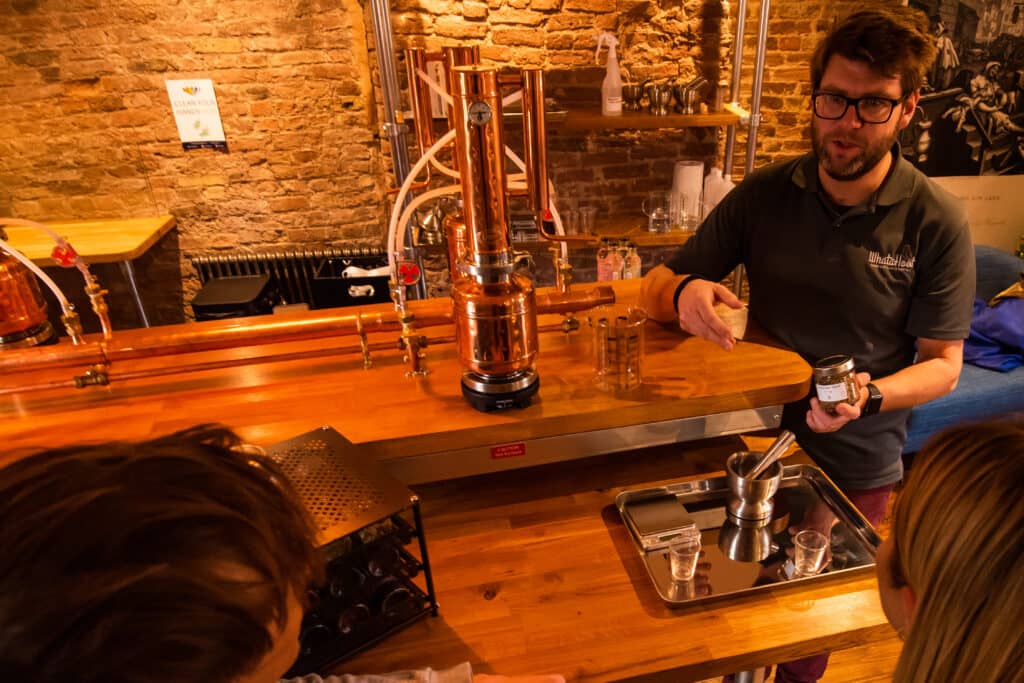
Wise Old Owl
Love gin? Then there’s nothing better than learning how to create your own at an award winning Norfolk distillery! And of course you get to take it home, made to your very own bespoke recipe dontcha know!
Nicky and Jason, owners of WhataHoot Gin, are never happier than when sharing their passion so they’ve created a fantastic range of experiences and masterclasses welcoming gin lovers to their wonderful boozy world. Go back to the classroom at their purpose-built Gin School in a beautiful heritage building at the heart of King’s Lynn.
For this 4 hour Gin Masterclass you’ll be welcomed to your workstations, each equipped with its own beautiful copper still, to learn the step-by-step process of gin distillation and discover how botanicals give each gin its distinct flavour. Then it’s time to design your own concoction, experimenting with over 30 botanicals from across the world including Madagascar, Egypt and Spain, as well as Norfolk’s famous lavender and sea samphire.
Highlights include:
- Making a 70cl bottle of gin to takeaway with personalised label
- Indulgent 4 Gin & Tonics during your session (per person)
- Discover the history of Gin and WhataHoot whilst on a Distillery Tour
- Enjoy a Norfolk inspired locally sourced seasonal grazing board supplied by Bank House
- Gin Making Experience Photos
A WhataHoot masterclass makes a brilliant present for gin lovers. Why not book for the whole gang? You’ll learn loads from top notch tutors while having fun in good company. That’s edutainment!

Distillery Tour
You’ll be warmly welcomed at this award-winning distillery and gin school in the heart of historic King’s Lynn.
Behind the handsome 1830s brick frontage on King Street is a Grade II listed 17th century warehouse and merchants’ yard, embodying the town’s proud global trading heritage. Now magnificently converted to a family-run bespoke distillery, it’s a beautiful space with wooden beams, open brick work and gleaming copper stills.
WhataHoot owner Jason will guide you through the building where you’ll learn more about its history and the company’s origins. Generous about sharing his passion for gin, you’ll discover how it’s distilled whilst experiencing the way botanicals give gins their unique flavours. And you’ll see where the famous Royal Estate Sandringham Celebration Gin is produced. A real exclusive as it’s only available to buy from the estate itself, just 8 miles from the distillery.
You’ll finish your tour being treated to a G&T in the delightful Spirit Lounge. Your new knowledge should help you pick out the distinct notes of WhataHoot’s Signature Dry Gin with its refreshing blend of traditional botanicals including juniper, coriander and citrus, perfectly balanced with the iconic Norfolk flavours of sea-samphire and lavender. Seriously smooth!
The hour’s tour gives you plenty of time to relax and enjoy your experience, chat to the staff, ask questions and learn more about gin making. And you even get 10% off in the Pantry shop! Cheers!

Cocktail Master Class
Take happy hour to a whole new level with an evening of cocktail making at WhataHoot, after all vodka might not make the world go round but it’s worth a shot…
This fine distillery has been converted from a 17th century warehouse in the heart of historic King’s Lynn. As well as the distilling and bottling suite, WhataHoot is home to a bespoke Gin School & Spirit Lounge where visitors can play around experimenting at a cocktail masterclass with a leading Norfolk mixologist.
You’ll be set up at an elegant bar station with mixology kit, spirits, liquors, juices and ingredients to add intriguing dimensions to your own bespoke creation. All you need to provide is a fabulous name!
Kick off with a champagne cocktail, then it’s time to get stuck in to mixing, muddling, and shaking – learning the skills to build some world-famous cocktails. There’s no rush, it’s all about perfecting your drink’s flavour and presentation with a twist of creative flair. You’ll also try out cool bar flaring skills like free-pouring, shaker spinning and bottle juggling. Eat your heart out Tom Cruise.
You’ll try 4 contrasting cocktails, make 2 and drink 2. Staying sober? Good decision – there are delectable mocktails available too! Then show off your bar flaring skills in a fun mix-off.
All guests receive a special certificate and everyone in the winning group gets a stainless-steel Manhattan cocktail shaker. The evening ends with vodka-based tipple. Who knew school could be this much fun?
Build your own itinerary
If you fancy creating your own itinerary for a day trip to Norfolk or a longer visit, it couldn’t be simpler. Just go to Search Activities and select from our wide range of free and paid-for experiences, saving any that capture your imagination with the click of a button.
Once you’ve finished, you’ll find all the information stored in My Favourite, where you can drag and drop activities to create your own day-by-day itinerary! You can download this to a calendar and even share it with friends.
